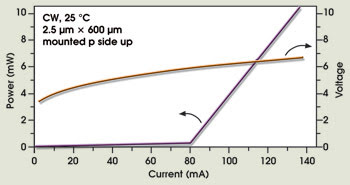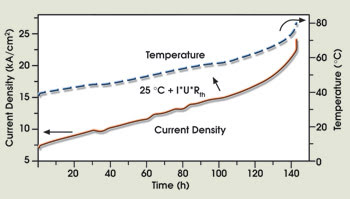New advances move GaN-based laser diodes toward commercial applications.
Volker Härle, Alfred Lell and Joachim Wagner
Short-wavelength lasers in the violet and blue spectral range are playing an important role in optical data storage and are receiving much attention in research centers around the world.
In 1998, Osram Opto Semiconductors GmbH in Regensburg, Germany, began research on GaN-based blue laser diodes, and shortly thereafter a consortium was formed. Fraunhofer Institute for Applied Solid-State Physics and research groups from the Universities of Braunschweig, Regensburg, Stuttgart and Ulm joined this national research initiative, which is partially funded by the German Ministry for Research and Education.
Short-wavelength semiconductor laser diodes in the UV, violet and blue spectral range are used in the new Blu-ray Disc standard for high-density DVDs that require diodes emitting at 405 nm. Such optical data storage media will be necessary for applications such as recording of high-definition television, where one hour of playing time will consume 10 to 15 Gb of storage capacity.
For comparison, today’s standard DVD, based on red-emitting laser diodes, has a capacity of only 4.7 Gb. The Blu-ray Disc (using a 405-nm laser) will have a capacity five to six times greater: between 23.3 and 27 Gb of data on a single-sided, single-layer DVD-size disc and about 50 Gb on a double-layer disc.
Laying the groundwork
Group III nitrides are the material of choice for most short-wavelength laser diode development, and the most common of these nitrides is GaN. Because GaN cannot be grown in large bulk crystals, sapphire and SiC are the alternative substrate materials for the epitaxial growth of high-quality GaN and related compounds.
A key factor in the successful production of GaN-based LEDs and lasers on an industrial scale is the development of stable epitaxial processes using a scalable growth-reactor technology. Another factor is the use of the most simple chip technology for rapid, reproducible, low-cost processing of devices in large quantities with high yield. Compared with sapphire, which is inexpensive, highly transparent and most widely used in GaN-based optoelectronics, SiC offers many advantages related to epitaxial deposition and device processing.
The principal advantage that SiC has over sapphire is the potential to realize a truly vertical chip structure with a substrate-side n-electrode. This design simplifies processing technology and packaging of LEDs. Group III nitride technology on SiC also enables the fabrication of high-quality laser mirrors by cleaving.
In addition, the SiC-based approach does not require the growth of a thick lateral n-conductive GaN layer underneath the laser waveguide and active region, thus avoiding problems arising from the second waveguide formed by this layer — a critical issue in sapphire-based technology. And SiC, with a thermal conductivity of 4.9 W/cm K, is an excellent heat conductor compared with sapphire, at 0.46 W/cm K, and GaN, at 1.3 W/cm K.
Despite the clear advantages of SiC, most of the leading research groups in this field employ sapphire-based technologies. The German consortium is also looking at growth and processing on sapphire substrates. This approach requires etched mirror facets and front n-contact technology, but allows on-wafer device testing and can be transferred rapidly to any GaN template or bulklike GaN substrate material without the need for developing suitable mirror cleaving and back-side processes. Even though SiC and sapphire are viable substrate materials, low-defect-density GaN substrates will be required for ultimate device performance.
Making progress
The consortium uses metallorganic chemical vapor deposition to grow a laser structure that consists typically of three In0.1Ga0.9N/GaN multiple quantum-well active regions with an Al0.2Ga0.8N electron-blocking layer sandwiched between Si- and Mg-doped GaN waveguide layers. These in turn are surrounded by Si- and Mg-doped AlGaN cladding layers, the latter followed by a GaN:Mg contact layer.
Specially designed ridge-waveguide technology made it possible to produce ridges as narrow as 1.5 to 3 μm, which is necessary to confine the threshold current and to enable continuous-mode operation. Reactive ion etching in a BCl3/Cl2/Ar plasma was used for ridge patterning, resulting in smooth and highly anisotropic etch profiles. Realization of ridge-waveguide laser diodes on insulating sapphire substrates requires a combination of resist mask and chemically assisted ion beam etching for ridge-waveguide definition, mesa for n-contacting and the fabrication of cavity mirrors.
For SiC-based devices, ohmic contacts are deposited on the p-GaN top contact layer and on the back side of the n-SiC substrate. Contacts to p-GaN, based on highly functional metals such as paladium, platinum or nickel with a gold overlay, were formed by annealing at temperatures of about 500 °C. After thinning the SiC substrate to about 100 μm, n-contacts based on nickel-titanium-gold layers were deposited on the back side. Finally, laser facets with a roughness of less than 0.3 nm rms, as measured by atomic force microscopy, were fabricated by wafer cleaving.
Laser results
Typical cavity lengths range from 400 to 600 μm. To reduce the threshold current, the scientists applied dielectric mirror coatings with a reflectivity of 98 percent for the high-reflectivity mirror and 50 to 70 percent for the output facet. Eventual device mounting and heat sinking takes advantage of the vertical current flow through the device and the excellent heat dissipating properties of the SiC substrate.
The first operating group III nitride laser diode was demonstrated in 1999 within the consortium. The laser structure, grown on a SiC substrate, was a gain-guided device with a 900-μm cavity length and cleaved, highly reflecting laser facets.
The laser could be operated in pulsed mode at room temperature. The threshold current density was below 20 kA/cm2 and the turn-on was about 25 V at an emission wavelength of 420 nm, which is in the blue-to-violet spectral range.
Further optimization of the epitaxial structure, also taking advantage of device modeling results, led to a major improvement in current injection and internal quantum efficiency. Combined with a ridge-waveguide design with ridge widths of less than 3 μm, these improvements resulted in a substantial reduction in threshold current from 1200 mA to less than 100 mA. In parallel contact, resistance could be reduced by improvements in surface preparation, contact metallization schemes and annealing conditions. As a result, operating current and voltage at threshold could be reduced to 70 mA and 13 V, resulting in a dissipated power of less than 1 W. In March 2001, continuous-mode operation at room temperature was achieved.
The consortium may have demonstrated the first and only continuous-wave blue GaN-based laser diode in Europe, the result of cooperation among its partners, combined with Osram’s experience in laser diodes based on other materials as well as in GaN-based LED technology. The company’s most recent advances have led to the introduction of the ThinGaN series of thin-film LEDs mounted p-side down.
While this work was being done, growth and processing of laser diodes on sapphire substrates simultaneously reached a certain level of maturity. The group was able to achieve threshold current densities of 18 kA/cm2 for devices with uncoated facets when tested on-wafer in pulsed operation.

Figure 1. Researchers in Germany have developed a blue laser diode that displays improved CW output power and voltage characteristics.
The continuous-wave output power and voltage characteristics of a SiC substrate based on a 2.5 × 600-μm ridge waveguide emitting at 407 nm, which was mounted p-side up and operated at 25 °C, are illustrated in Figure 1. The CW threshold current (Ith) amounts to 80 mA, corresponding to a threshold current density (Jth) of 5.3 kA/cm2, while threshold voltage and slope efficiency are Uth = 5.9 V and η = 0.2 W/A, respectively.
From minutes to hours
CW operation at 1 mW has been extended from a matter of minutes to nearly 150 hours at room temperature without employing sophisticated defect-reduction schemes (Figure 2). This increase was achieved mainly by a reduction in operating voltage as well as by improved heat sinking to reduce thermal resistance. The use of appropriate low-defect-density GaN templates and substrates would improve reliability further.

Figure 2. The lifetime of the device has been extended from a few minutes to nearly 150 hours by reducing the operating voltage and improving heat sinking.
Other areas that require robust and compact solid-state laser light sources are printing, displays and medical diagnostics. Office laser printers using blue lasers will be smaller and more precise than today’s machines, which use red laser light. Because of the blue laser’s shorter wavelength and inherently smaller focus spot size, the scanner unit inside a printer can be smaller. Despite reduced dimensions, these printers will have a potential resolution of up to 2400 dpi, or about twice that of current models.
Short-wavelength diode lasers also will find use in microdisplays, PC monitors and laser TV, where the power requirements increase considerably. So-called retina-scanning displays, which directly project the image into the human eye and eliminate the need for an external projection screen, are under development as well.
In the long run, when significantly higher output powers and power efficiencies are achieved for short-wavelength laser diodes, semiconductor lasers may become efficient sources for solid-state lighting. Semiconductor lasers use UV laser diodes, whose output is changed into visible light by luminescence converters. Further, highly efficient high-power short-wavelength laser diodes will find applications in processing materials, such as UV-curable polymers.
According to Reuters, Sony has announced plans to start sales of the first DVD recorder that uses a violet laser light source (see “Violet Lasers Enter Mass Production,” page 68). Nevertheless, DVD market experts state that consumer demand for high-density DVD just isn’t there yet. Other experts think blue-laser hardware will be pushed forward by the time high-definition digital broadcasting becomes widely available. It is only in its earliest stages and probably won’t be implemented in commercial products for a few years. Most experts expect any form of high-density DVD to be five to 10 years away from mainstream consumer acceptance.
The flip side is that the wait for acceptance will give researchers time to boost the performance of GaN-based blue laser diodes. It also will grant them time to improve on the processing technology to bring manufacturing costs down to a level acceptable for a broad consumer market.
Meet the authors
Volker Härle is head of GaInN R&D at Osram Opto Semiconductors GmbH in Regensburg, Germany.
Alfred Lell is project manager for the blue laser activities at Osram, where he coordinates the R&D activities on GaN-based laser diodes within the national research initiative funded by the German Ministry for Research and Education.
Joachim Wagner heads the optoelectronic materials department at Fraunhofer Institute for Applied Solid-State Physics. His research interests include compound semiconductor materials and quantum structures as well as their application to optoelectronic devices.